 A Qualified Mortgage (QM) is a defined class of mortgages that meet certain borrower and lender standards outlined in the Dodd-Frank regulations. These are made in conjunction with an Ability-to-Repay (ATR) standard that requires lenders to evaluate and ensure that a borrower will be able to meet his or her mortgage obligations.
A Qualified Mortgage (QM) is a defined class of mortgages that meet certain borrower and lender standards outlined in the Dodd-Frank regulations. These are made in conjunction with an Ability-to-Repay (ATR) standard that requires lenders to evaluate and ensure that a borrower will be able to meet his or her mortgage obligations.
ATR requires that a lender make a good-faith effort to determine that you have the ability to repay your mortgage before you take it out. If a lender makes a Qualified Mortgage available to you it means the lender met certain requirements and it’s assumed that the lender followed the ability-to-repay rule.
The Ability-to-Repay rule outlines eight criteria the lender must use to determine if you can or cannot make mortgage payments. For each application, the lender must review:
- Your current or reasonably expected assets or income
- Your current employment status
- The expected monthly payment on the mortgage
- Any monthly payments on any other mortgages, such as a piggybacked second lien
- Any monthly payment for mortgage-related obligations (i.e. property taxes, PMI, HOA fees, required insurance)
- Your current debt obligations, including any alimony and child support requirements
- Your monthly Debt-to-Income (DTI) ratio, and residual income available to satisfy normal living expenses
- Your credit history
If a lender fails to comply with ATR and the borrower can prove this in court, the lender could be liable for up to 3 years of the loan's interest costs, any charges and fees the borrower paid and the borrower's legal fees.
If you're wondering why lenders have been sticklers for documentation regarding your income and credit, ATR is the reason.
Okay, you're passed the ATR standard and can be offered a Qualified Mortgage. To be considered a QM, the loan being offered also needs to meet certain standards. In general, qualified mortgages don't allow for certain "risky" features or loan terms and are thought to be more stable and "safe" for borrowers.
The Qualified Mortgage definition bans loans with:
An "interest-only" payment period, when you pay only the interest without paying down the principal, which is the amount of money you borrowed. Interest-only payment plans were mostly applied to hybrid ARMs, but were also found on some fixed-rate mortgages for a time, too. These are still available in the market to some borrowers but they don't qualify as a QM.
"Negative amortization", a process where you aren't making a large enough required payment to cover all of the interest due on the loan. Deferred interest is added back onto the loan amount, causing your loan's principal to increase over time, even though you are making payments. These payment structures were offered as a component on so-called "Option ARMs".
Mortgages with "balloon" payments, which require the full repayment of the loan after just a few years' time. A typical balloon mortgage might see you make payments as though the loan has a 30-year repayment term, but the remaining outstanding balance of the loan becomes fully due and payable at the end of the seventh year. These were attractive to some borrowers as they often offered interest rates lower than comparable traditional 30-year loans. Balloon mortgages are still allowed to be made by small lenders with assets under $2 billion or who make fewer than 500 residential mortgages per year.
"No-documentation" loans. At their face, these of course run afoul of ATR rules. For a time, these were prevalent in both prime and subprime mortgage markets. While true no-doc loans are virtually non-existent, non-QM lenders do offer "alt-doc" and "lite-doc" mortgages to some borrowers, but they don't qualify as a QM.
Loan terms that are longer than 30 years. At one point in the last housing boom, with home prices and mortgage rates rising, 40-year mortgages came back onto the mortgage scene as they helped to keep payments low. Later, in fact, these were often used in loan modification programs such as HAMP. With a fixed interest rate, borrowers liked these, but the long-term interest costs make these a very costly option. While they may be available at times in the market, they can't be QMs.
Points and fees that exceed 3% of the loan amount. One component of the subprime mortgage market was loans with high points and fees. Often buried back into the loan amount, these steep costs in turn stripped equity from borrowers; when combined with loans that needed to be refinanced fairly frequently, they contributed to the underwater mortgage crisis when home prices declined. Certain fees, such as an upfront FHA mortgage insurance premium aren't included in this tally. These point-and-fee threshold limits depend on the size of your loan, and are indexed for inflation and change each year.
2025 Points and Fees Threshold for QMs
• 2.25 or more percentage points for a first-lien covered transaction with a loan amount greater than or equal to $134,841;
• 3.5 or more percentage points for a first-lien covered transaction with a loan amount greater than or equal to $80,905 but less than $134,841;
• 6.5 or more percentage points for a first-lien covered transaction with a loan amount less than $80,905;
• 6.5 or more percentage points for a first-lien covered transaction secured by a manufactured home with a loan amount less than $134,841;
• 3.5 or more percentage points for a subordinate-lien covered transaction with a loan amount greater than or equal to $80,905; or;
• 6.5 or more percentage points for a subordinate-lien covered transaction with a loan amount less than $80,905.
"Subordinate liens" are most commonly home equity loans and second mortgages.
For all categories of QMs, the thresholds for total points and fees in 2025 were also lifted to:
• 3% of the total loan amount for a loan greater than or equal to $134,841;
• $4,045 for a loan amount greater than or equal to $80,905 but less than $134,841;
• 5% of the total loan amount for a loan greater than or equal to $26,968 but less than $80,905;
• $1,348 for a loan amount greater than or equal to $16,855 but less than $26,968; and
• 8% of the total loan amount for a loan amount less than $16,855.
An interest rate that falls below a threshold defined by the CFPB. When ATR was implemented, and in addition to meeting the other requirements, the regulation called for a 43% maximum Debt-to-Income (DTI) ratio for a loan to be considered a Qualified Mortgage. At the same time, a "temporary" exemption to this bright-line rule was implemented for loans purchased by Fannie Mae and Freddie Mac (called the "QM patch" or "GSE patch"). With this exemption, Fannie and Freddie were actively backing loans with DTIs as high as 50% for a time that were still considered to be QM.
Meanwhile, loans not sold to Fannie/Freddie -- private market mortgages, often held on lender books -- could not have DTIs above 43% and be considered QM, and so became non-QM loans, where there was considerably less of a liquid market to sell loans and fewer legal protections for lenders or investors. As such, this private component of the market couldn't grow, and in fact has even contracted sharply in time of financial-market stress, leaving some borrowers with no access to loans.
The "QM patch" was slated to expire the when GSEs exited federal conservatorship or January 10, 2021 (whichever came first). Since Fannie and Freddie didn't exit conservatorship by that date, the CFPB had to come up with a more permanent solution and replaced the old DTI standard with a new interest-rate based series of thresholds to determine ATR compliance to meet QM standards.
Starting October 1, 2022, the old 43% DTI standard was discontinued; in its place is a set of reference interest rates. Loans meeting QM criteria are considered compliant with ATR regs "if the annual percentage rate [of the mortgage] does not exceed the average prime offer rate (APOR) for a comparable transaction by 1.5 percentage points or more as of the date the interest rate is set." Under this standard, the "loan receives a conclusive presumption that the consumer had the ability to repay", and so provides the lender with greater legal protection against lawsuits.
At the same time, "A loan receives a rebuttable presumption that the consumer had the ability to repay if the annual percentage rate exceeds the average prime offer rate for a comparable transaction by 1.5 percentage points or more but by less than 2.25 percentage points." That is to say, the consumer can more easily challenge that a lender failed to properly assess their ability to manage the loan if their loans Annual Percentage Rate rate is 1.5% to 2.25% above the published APOR for a similar transaction.
What is the Average Prime Offered Rate (APOR)?
"The Average Prime Offer Rate (APOR) is an annual percentage rate that is based on average interest rates, fees, and other terms on mortgages offered to highly qualified borrowers," says the CFPB. Originally, the data used to calculate APOR came from Freddie Mac's weekly Primary Mortgage Market Survey (PMMS); after a change in PMMS methodology in 2023, the data that creates APOR comes from Intercontinental Exchange Mortgage Technology (ICE Mortgage Technology). These base rates for fixed and adjustable-rate mortgages are then compared against individual loans lenders make to see if they meet the test to be a QM, are a non-QM or even a "Higher Priced Mortgage Loan", which brings new rules and regulations into play.
Does it matter if a loan is QM or not?
OK, so you and the lender meet ATR and QM requirements. What does this actually do for both of you? Theoretically, you get a mortgage for which you have been fully vetted, and so are less likely to default in the future.
For the lender, meeting ATR and QM standards offers some specific legal protection; QM loans that meet certain pricing limits provide lenders with a "safe harbor" (called a "conclusive presumption") provision that limits a borrower's ability to sue on grounds that the lender didn't properly measure his or her ability to repay the loan. Non-QM loans and even certain "higher cost" QM loans don't afford this protection to the lender, where a "rebuttable presumption" standard is used, giving borrowers somewhat stronger legal rights that the lender didn't properly employ ATR standards before making the mortgage loan.
For QM loans, the standard is applied using a federal formula based on the Average Prime Offered Rate (APOR) for a mortgage, plus 1.5 percentage points. Below this threshold, a loan is considered to provide the lender a "safe harbor". Above it, it is considered a "higher priced" mortgage and is subject to the "rebuttable presumption" above. This "higher-priced" standard also applies to closed-end second mortgages, too, but the formula is APOR + 3.5 percentage points.
Can I get a non-QM mortgage?
Sure. In fact, non-QM lending is a growing segment of the mortgage market. These include certain kinds of jumbo mortgages, hybrid ARMs with interest-only payments, loans with different borrower documentation to prove income, such as bank statements instead of classic W-2 forms, portfolio loans not sold to the GSEs with higher-than-threshold interest rates and other such characteristics. Given sizable losses on them, we probably won't again see loans with negative amortization, but never say never. These kinds of loans flourished in the 1980s, only to flame out and disappear from the mortgage menu for 20+ years before returning. Mortgage market makers continue to look to innovate, and the non-QM space is where new and novel mortgage products will come from in the years ahead.



